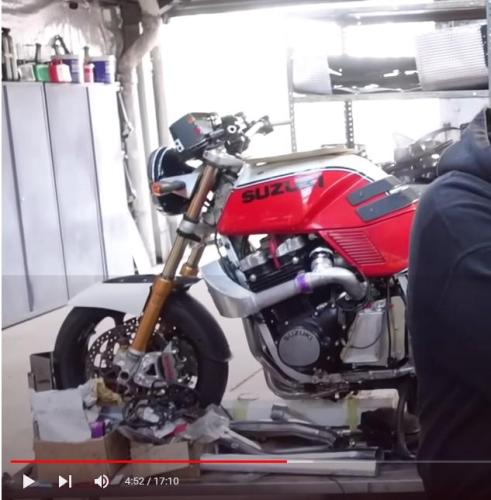-
Posts
5,755 -
Joined
-
Last visited
Content Type
Profiles
Forums
Events
Everything posted by Gixer1460
-
Not saying this is right or wrong way - but its my way LOL Turn carbs right way up so float is drooping and hold them in a vice or suchlike to give two hands free. Then move float up until the tang over the float valve plunger is just starting to compress it, then measure from middle of float seam to float bowl gasket surface. Alternatively mount rack in vice all assembled and add 4No. clear plastic tubes to bowl drains and secure them beside each carb body, open the drain taps with free fuel flow from header tank - once all bowls full you should be able to see relative levels compared to one another and compared to what manual says they 'should be'
-
Even more bizarre!
-
Saw this on a totally non bike YT channel and wondered if anyone recognised it? It has an interesting IC at the front but you can't see much more - its all 'background' type viewing. If you want to see it on YT this is the link : https://www.youtube.com/watch?v=qU2BI7WignY&t=292s - Craig @ DynoTorque is the business!
-
Besides having the engine running as well as you can get it, plenty of fuel as a long dyno session will drink it, plenty of your methanol injection fluid, tyres correct pressures, take off anything that is liable to fall off or get in the way of straps to hold bike down and make sure that the tuner knows his way around your ecu's software - you don't want him 'learning' on the job!
-
I believe that the cam cover is only integrated to the extent of the SACS cooling circuit. All head lubrication is via the ports,channels and galleries in the crankcase, then barrels and into the head to the cam bearings. If it wasn't for the gallons of oil being pumped up the cooling lines, you could run the engine, cam cover off, to see if decent amounts of oil were getting to where it was required!
-
Thats why they quote air gaps! Less air gap = harder spring effect and that can be felt!
-
I was guessing / hitting the old memory on wire colours and using 'std.' suzuki colours but as you've indicated there is a variation. The Orange/white will be ign. live power in and is common to both coils. #1 yellow/white is LT trigger. I'm wary about saying Black/white is correct as that colour is usually an earth or ground wire colour ! Are you sure its white as over the years yellow will pale significantly so it could have been originally yellow and not white? On your diagram the LH coil (#1) has spark leads going to cyl 1 and cyl 4 . . . . . . . the RH coil has spark leads going to cyl 2 and cyl 3. It makes no difference which post is used for which lead as long as they go to the right coil. If you are likely to get confused just put small cable ties around each lead - 1 for cyl 1, 2 for cyl 2 etc - its fool proof and even easy to identify in the dark !
-
One coil feeds cyl 1 & 4 and the other does 2 & 3. White LT wire goes to coil 1, black/yellow does coil 2
-

Q for the Rajay users: is my middle section right ?
Gixer1460 replied to FJD's topic in Forced Induction
If people were that interested in getting a 'proper running bike' that ticked all the performance boxes you mention, they wouldn't be building a draw through install ! For all their downsides, they are cool, oldskool and get the job done abit if moderately inefficiently! -

Q for the Rajay users: is my middle section right ?
Gixer1460 replied to FJD's topic in Forced Induction
Square / rectangular ones are a) a damn sight easier to fabricate, b) add pads for sensors & ports etc. and c) generally more compact in a space limited area! -
First bit is no bad thing, but is equally applicable if cooler is mounted, fittings down, oil DOES NOT drain at engine off - its an urban myth perpetuated by people who don't understand physics! If the feed lines to the sump remain under oil, air cannot enter cooler so it cannot drain. When changing oil there is a stong chance that these lines will be uncovered and so cooler will drain so be prepared for additional oil in catch basin and for filling - most coolers will hold between 0.5 - 1.0L - just fill sump to regular line after oil has circulated.
-

Q for the Rajay users: is my middle section right ?
Gixer1460 replied to FJD's topic in Forced Induction
I have a couple of Rajay Manuals but as they are pdf's - I can't post them up here! PM an email addy and i'll forward them. Rajay spared are getting ridiculously hard to source so good luck with seals and bearings and afaik, they don't really appreciate restricted oil flow due to their single bearing arrangement. -
And the crank ie. a new one!
-
Hope you have deep pockets afaik you can't get 1460 with just a big block / bore / pistons!
-
Never heard or seen that mod before - care to give any known details? I guess the issue is providing fuel to it, in an 'orderly' way and consequently not over-fuelling it ? Thinking sideways for a moment - I wonder if the fuel stage from a wet nitrous system could be used to similar effect as a thunderjet? ie. switched on big boost but independent of the carb mixture workings but still easily jettable - just a thought?
-

Heavy duty parts for short stroke 750?
Gixer1460 replied to IhmeJanneFIN's topic in Forced Induction
He no be here since last September so may not see this? But if the OP is Finish he's probably been snowed in since then LOL! -
Bear in mind Summit's advice is generally based on single cam engines where any + move on one lobe has a corresponding - move on its corresponding partner. Its maybe why so many cams are produced just to obtain different LCA's?
-
That seems to be true, probably less overlap helps the torque - I think shorter numbers are recommended for forced induction also for much the same reason?
-
They do indeed! I destroyed a EFE top end using std rockers with some G4 cams - ran off the pads and wore the cams out in double quick time.
-
As said, only real way of comparison is use an engine dyno - a chassis dyno is just too much faff, and you'd have to be prepared to write off a couple of days to get meaningful results. Personally i've always had good results with 110 / 110 so never felt the need to chase other numbers.
-
For a good machinist, its not a big deal. Probably the longest operation is getting the top of the case parallel to bed of the machine. Centering the boring head on each bore is pretty painless. Agreed though that machining is the way to go for tighter fit. If, for example you took your case now to a machinist, say, for bigger sleeves, the job would be more complicated due to the DIY metal removal not leaving a uniform concentric circle to centre the machine on - pros & cons!
-
Blueprinting anything is a waste of time and money UNLESS you are restricted by racing class regulations! It will cost more money to blueprint a head than to tune it for performance - don't kid yourself that it will be cheap!
-
Appalogees - wasn't clear! Oh - and like i'm the first to commit that particular faux pas ! ! !
-
Eh ? ? ? Using a 1052 crank and without changing the bore - you'll end up with . . . . . . 1052cc ! You could put 1m long rods on the crank and you'd still only get 1052cc! You can ONLY change capacity by varying either the bore dimension and / or the stroke length !



